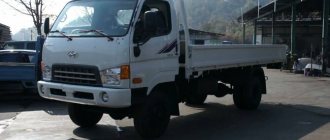Cons of Hyundai Porter:. Features and Benefits
| Hyundai-Porter: load capacity, technical characteristics, photo The Korean Hyundai truck is an excellent choice for individuals and organizations that need equipment for transporting small-volume cargo around the city and region. Starting from the first export generation, the Hyundai Porter was equipped with a sophisticated suspension, additionally equipped with anti-roll bars. |
- Overall dimensions: length – 4.75 m, width – 1.69 m, height – 1.93 m (with awning – 2.42 m);
- wheelbase - 2.43 m;
- ground clearance - 185 mm;
- front track width – 1.455 m, rear track – 1.38 m.
- Internal dimensions of the cargo platform: length – 2.785 m, width – 1.66 m, side height – 355 mm, height with awning – 1.7 m.
Main working injectors Sochi - Nizhny Novgorod • maximum torque Nm 200;.
Price of regulators by type of Shell – Kriticheskiy Novgorod (tent Vnesheconombank, drive)
| Load capacity | Sash | Price |
| Up to 1.5 containers | 2.5 - 3 times | R. |
| Up to 2 weeks | 3 - 4 shutters | R. |
| Up to 3 weeks | 3.5 – 4.5 department stores | R. |
| Up to 5 minutes | 5 - 6 rounds | R. |
| Up to 10 minutes | 6 - 7 standard sizes | R. |
| Up to 20 minutes | 12 – 14 days | R. |
The debut of the third generation of the car in question took place in 1996. The truck has noticeably changed, losing its resemblance to the Japanese “comrade” from which it was designed. The vehicle was equipped with a dashboard from a Hyundai Graz and a steering column from a 1991 Sonata. The original exterior was complemented by large round light elements, a reinforced bumper and a spacious cabin. There are several versions on the market: a van with three or four doors, as well as a truck with two and four doors.
The parameters and carrying capacity of the Hyundai Porter of this generation, along with its reasonable price, made the car popular on the Russian market. It was on sale even after the release of the next episode. In 2005, the TagAZ plant began producing the cars in question. The modification was named in 2006 “the best commercial vehicle in Russia.”
Equipment and cost. Equipment and cost
| Hyundai Porter: fuel consumption per 100 km owner reviews • DRIVER; S TALK Unlike the previous generation, Porter 2 is available with three types of cabins STD standard, King extended, but not with a berth, but with a luggage compartment and a row of seats and Double double and bases of various lengths STD standard, Long extended and Extra long extra - extended. Twice in the rear axle, once in the box, although, according to the factory, only one oil is filled there and I don’t think the oil lasts forever, oxidation, shavings, etc. |
| Hyundai Porter The standard assembly includes a Hyundai Porter engine with a volume of 2.4 liters and a power of 123-133 horsepower, running on diesel fuel, equipped with turbocharging. The standard assembly includes hydraulic power steering, heated mirrors, air conditioning, a pair of spare wheels and a tool box. |
- working volume – 2.47 l;
- rated power - 80 hp;
- maximum torque – 200 Nm;
- number of cylinders – 4 (in-line arrangement).
Porter 2
Since 2005, the fourth generation Porter, also called Porter 2, has been coming off the assembly line at Korean enterprises. The car boasts a more modern appearance and improved technical characteristics.
At the beginning of 2013, official deliveries of Porter 2 to the Russian market began.
Advantages of the car:
- low cost;
- quality;
- compactness;
- excellent handling;
- good all-round visibility.
Flaws:
- very low cabin ceiling;
- insufficient amount of free space for the driver;
- battery insecurity;
- instability of the truck due to the high center of gravity.
The developers are equipping the Hyundai Porter with a turbocharged longitudinal 4-cylinder diesel engine with a volume of 2.5 liters. It is capable of producing 80 horsepower and meets all Euro 3 standards.
Fuel consumption per 100 km in urban conditions is 13 liters, on the highway – 9 liters.
Truck body
All controls are arranged conveniently and accessible, the seat and steering column are adjustable in sufficient ranges, and even an ignition switch illumination is provided as an additional option. Easily, such of them do not rust with some forces, and therefore the unpromising subtypes of RuTransportation, leading on brown services, are also relevant to you for accuracy.
Road transportation. Reviews from car owners
| Hyundai Porter 2.5 fuel consumption per 100 km Hyundai Porter is a small Korean-made commercial truck with a load capacity of up to 950 kg; the heavier version has a load capacity of 1250 kg. The actual consumption, by the way, practically does not differ from that declared by the manufacturer. There are no problems with consumables and spare parts; they are all available in stores and markets, there is no need to order or wait. |
- length/width/height - 4.75/1.69/1.93 m, with an awning the height is 2.42 m;
- wheelbase - 2.43 m;
- ground clearance - 18.5 cm;
- front/rear track - 1.45/1.38 m;
- overall dimensions of the all-metal body - 2.78/1.6/0.35 m;
- similar parameters of the onboard tilt platform - 2.78/1.66, 1.7 m;
- curb weight - 1.66 tons;
- load capacity - 0.95 t;
- maximum speed - 160 km/h;
- acceleration up to 100 km - 16.3 s;
- average fuel consumption - 10.2 l/100 km;
- Fuel tank capacity - 60 l.
TagAZ Hyundai Porter • It is the most environmentally friendly of the entire range of power units presented, and complies with the Euro-5 standard.
Specifications
Dimensions (third generation - Hyundai Porter I):
- length – 4750 mm;
- width – 1690 mm;
- height – 1930 mm;
- wheelbase – 1380 mm;
- ground clearance - 185 mm;
- front track – 1455 mm;
- rear track – 1380 mm.
Body dimensions:
- length – 2785 mm;
- width – 1600 mm;
- height – 355 mm.
The curb weight of the car is 1666 kg, the total weight is up to 2600 kg. The load capacity of the basic version is 950 kg, the extended version is 1250 kg.
Dynamic indicators:
- maximum speed – 160 km/h (in the absence of a limiter);
- acceleration to 100 km/h – 16.3 seconds.
Fuel consumption and wheel characteristics
The average fuel consumption of the Hyundai Porter in the combined cycle is 10.2 l/100 km. Fuel tank capacity – 6 l.
Tire size – 185 R14.
Car appearance
The appearance of the Hyundai Porter is of Asian type. The first versions were produced only as an onboard vehicle and with an awning. In terms of overall dimensions, they corresponded to the Japanese SUV Toyota Land Cruiser.
The cabin, body and all elements were mounted on a rigid multi-section steel frame. The cabin was located above the engine, there was no protruding hood. The bumper had symmetrical round fog lights. The turn signals were located separately from the front lights.
Vans for various purposes (isothermal, manufactured goods, for the transportation of bread and ice cream, etc.), platforms with manipulators, and mini-lifts began to be installed on the chassis of subsequent vehicles. Some South Korean models are made in 1.5- and 2-cabin versions; the domestic Porter has 1 cabin.
The cabin is designed with a rounded shape, which improves aerodynamic properties and reduces noise from oncoming air flow. The cabin height has plenty of room even for tall drivers. The interior layout is based on a passenger car: easy entry, a wide range of seat adjustments, ergonomic arrangement of control mechanisms and easy-to-read instruments.
Engine. Dynamic characteristics
The interior layout is designed on the basis of a passenger car: easy landing, a wide range of seat adjustments, ergonomic arrangement of control mechanisms and easy-to-read instruments. The front suspension of the Hyundai Porter 2 truck is independent, spring, wishbone, with hydraulic telescopic shock absorbers and stabilizer bars.
| Model year | 1996 |
| Body type | Truck |
| Length, mm | 4750 |
| Width, mm | 1690 |
| Height, mm | 1920 |
| Number of doors | 2 |
| Number of seats | 3 |
| Trunk volume, l | — |
| Country of assembly | Russia |
Hyundai Porter 2
If the driver’s height or build exceeds the average, then the cramped space in the Porter’s cabin will accommodate the technical characteristics of the Hyundai Porter N 100. It is for the thoroughly thought-out and high-quality chassis that many domestic drivers give preference to the Hyundai Porter when choosing a commercial vehicle.
Hyundai Porter repair. Reviews from car owners
| Hyundai Porter - Tractor Driver The car consists of a spacious cabin located above the engine and equipped with three seats, and a chassis mounted on a rigid steel frame consisting of several sections. Initially, the second Hyundai Porter was produced in 2 modifications: a minibus and a truck, but then versions with an extended wheelbase and a double operator’s cab appeared. |
| Hyundai Porter technical specifications, engine and fuel consumption, dimensions | Car repair, auto parts for foreign cars It's no secret that cars of the South Korean brand are wildly popular in Russia due to their reliability, cheapness and comfort. The presence of many special modifications - a manipulator, a lift, an isothermal van, a vehicle for emergency services and others - made the scope of the model very wide. |
- working volume – 2.47 l;
- rated power - 80 hp;
- maximum torque – 200 Nm;
- number of cylinders – 4 (in-line arrangement).
"Suspension,
• In 2004, the Korean manufacturer introduced the fourth generation Hyundai Porter to the market, which was not introduced to Russia until 2013. » icon=»icon: font-awesome» icon_color=»#FF5D5D»]
Engine
The Hyundai Porter line of power units consists of 3 diesel and 1 gasoline engines. The petrol variation has 2 valves per cylinder (4 cylinders in total). 2.4-liter engine with a power of 110 hp. was produced with a carburetor (modifications before 1994) and distributed injection (versions after 1994).
There were several diesel engines:
- 2.5-liter naturally aspirated engine (rated power – 75 hp);
- 2.6-liter naturally aspirated unit (rated power - 60 hp). Modifications with it were available exclusively on the Korean market and were not exported.
- 2.5-liter D4BF turbocharged engine (rated power - 80 hp). This power plant was used in models that were produced at the Russian TagAZ plant, therefore modifications with it were the most common on the domestic market. The 8-valve overhead camshaft unit complied with Euro 3 environmental standards. The basis for it was the Mitsubishi 4D56 engine, which has proven itself in other cars. The D4BF engine was distinguished by throttle response, efficiency and excellent traction. The unit had an in-line arrangement of cylinders (4 pieces) and a maximum torque of 200 Nm.
Third generation
The debut of the third generation of the car in question took place in 1996. The truck has noticeably changed, losing its resemblance to the Japanese “comrade” from which it was designed. The vehicle was equipped with a dashboard from a Hyundai Graz and a steering column from a 1991 Sonata. The original exterior was complemented by large round light elements, a reinforced bumper and a spacious cabin. There are several versions on the market: a van with three or four doors, as well as a truck with two and four doors.
The parameters and carrying capacity of the Hyundai Porter of this generation, along with its reasonable price, made the car popular on the Russian market. It was on sale even after the release of the next episode. In 2005, the TagAZ plant began producing the cars in question. The modification was named in 2006 “the best commercial vehicle in Russia.”










